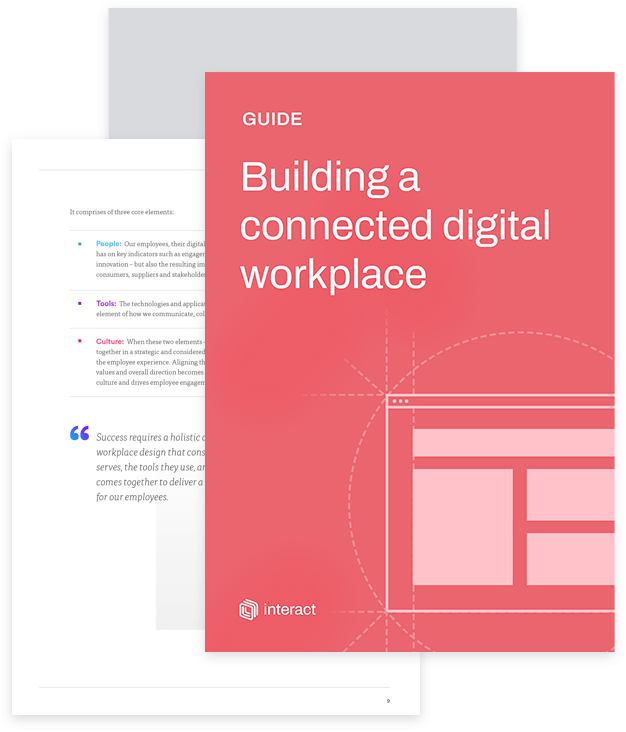The digital workplace is now well-established and continuing to evolve. But how do we ensure our workplaces work for us, and retain a human balance?
Digital transformation is no longer a future trend but a critical organizational strategy to survive and stay competitive in today’s markets.
The use of technology and computers has become so prevalent within our personal and working lives, organizations are quickly changing in order to succeed and compete against those companies who were ‘born digital’. Workplaces are no longer seen as physical office space, but a digitally connected workforce with the ability to work and communicate from any location at any time.
The definition of a digital workplace, in simple terms, is a digital environment where employees can effectively communicate, innovate, collaborate and work together to achieve business objectives.
Do you consider your organization to be a digital workplace?
- Can your employees interact socially and collaborate online?
- Are your staff equipped to provide great customer service?
- Can your employees access the right information when they need it?
- Do your frontline staff know who your leaders are and the business values?
- Can you reach your staff in a crisis?
- Do you have a mobile app that allows your staff to reach this information on the go?
In this new digital generation, the ability to work from any device in any location is expected. Employees want everything in one place, faster connections, instant messages, instant answers.
However, undertaking a digital transformation has its challenges; do they outweigh the rewards? In this blog we explore the pros and cons of adopting a digital workplace and how organizations can create a human balance.
Building a connected digital workplace
Pros
Increase Employee Engagement

‘Only ‘13% of employees worldwide are engaged at work’
Gallup
In the twenty-first century, businesses need the majority of their workforce to be engaged in order to survive competitors and stay ahead within their industry. Engaged employees are motivated, passionate and invested in the business. Their goals are aligned with the business objectives and they want to see themselves and the organization succeed.
However, those who are not engaged are the opposite. They are passing time and have no passion for their work. This group may become actively disengaged, spreading negative energy with colleagues which can result in an unhealthy company culture.
Investing time to engage the disengaged percentage is an effective approach to increase performance and sustain organizational growth. An engaged workforce is a company’s greatest asset.
Businesses who support and care for their staff are more likely to identify a disengaged workforce. Therefore, their wellbeing should be a priority. Recognizing who your employees are, their values, beliefs and goals is the first step to increasing their engagement and performance.
Adopting a digital workplace can increase engagement by:
- Allowing staff to easily communicate and collaborate. Employees can blog, give recognition and reward their peers, creating a social buzz and an interactive culture.
- Making documents accessible from one place and ensuring they are easy to access, which provides a better user experience and increases the use of digital platforms and engagement.
- Enabling organizations to measure engagement, conduct pulse surveys, and keep up-to-date with your employees’ wellbeing and happiness at work.
- Creating a virtual company culture, by displaying company values where everyone can see them and incorporating values in everyday tasks.
- Adjusting the recruitment process, employing managers who are emotionally invested in the organization’s mission and are passionate about their position. This can then be easily communicated across business.
- Investing in training and development, using technology to make it fun for both employees and managers.
- Using communication platforms to create consistency across the company, keeping everyone updated and in ‘the know’ about company changes and creating a strong employer brand.
Improve Communication
The Holmes Report states that in recent years poor communication has cost organizations $37 billion, due to employees simply misunderstanding job functions, business processes and policies. Due to a mixture of leadership styles and differences in employee work styles, communication will always be a challenge.
However, the digital workplace is a solution to creating an effective communication channel as it allows the organization and its employees to connect and communicate with everyone at any time. Departments can easily communicate through instant messages using platforms like Microsoft teams or Slack, and remote staff can easily communicate and keep up-to-date with business changes.
The organization can communicate changes, news or general information. By ensuring everyone is receiving the same communication at the same time, senior managers increase consistency and transparency.
Whilst allowing your workforce to choose their preferred methods of communication, the digital workplace also provides a way for them to be creative, share ideas and give feedback. In addition, better communication helps the business to mitigate conflicts, create a strong company culture and employer brand, and build stronger employee and customer relationships.
Building a connected digital workplace
Attract and retain talent
Attracting and retaining talent is a constant challenge faced by most businesses, especially those who lack a strong employer brand. Managers continue to struggle to engage existing talent, manage their performance and create a company culture that attracts new talent.
‘Almost one-third of senior leaders cite finding talent as their most significant managerial challenge’
McKinsey
However, businesses now have the opportunity to exploit technology and use it as an advantage to add value to their organization and customers. A digital workplace allows businesses to capitalize on technological advancements through centralizing organizational information and processes, creating a social network and collaboration platform thus building a strong employer brand and attracting talent.

According to Deloitte, businesses with a social network found a median 20% increase in employee satisfaction. Allowing staff to interact, collaborate, give rewards and recognition improves overall engagement and happiness at work. A shared digital space such as an intranet is a great to tool to create a social network, allowing the employer to communicate effectively, measure performance and enhance employee engagement and retention.
As Baby Boomers are starting to retire, they take their experience and knowledge with them. This will start to impact business performance, value and overall productivity. Adopting a digital workplace allows businesses to document and store this knowledge for the new digital generation – millennials and generation z.
They are
With Millennials set to make up half the workforce, providing this generation with the knowledge, tools and information they need is critical to maintaining productivity and competitive advantage. If you want innovation and collaboration, this workforce needs the tools to do so: otherwise, they risk being lost to a competitor.
Increase Revenue

Digital transformation will have a positive impact on revenue as it increases overall efficiency in business processes, saving time and resources whilst maximizing capabilities.
A centralized internal comms platform such as intranet can help reduce the amount of time employees spend gathering and looking for information, such as policies, procedures, legal compliance and colleague information. An intranet provides a document management solution with a quick search engine which significantly reduces the time employees would usually spend gathering information.
Businesses invest a large amount of their budget into recruitment and onboarding; however, with the right tools, expenditure can be reduced. For example, an intranet allows a business to customize pages entirely for new starters, provide detailed documents, training videos and forms. Whilst providing a unique user experience it also allows new starters to quickly engage with their new peers. This reduces the amount of human resources usually required for the training processes, therefore, reducing the amount spent on wages and training.
Cons
Loss of interpersonal communication skills

The main goal for adopting a digital workplace is to improve online communication and productivity across the entire organization. However, instant messaging and virtual video platforms such as Skype and Slack have significantly reduced traditional communication methods. Face-to-face and group meetings are becoming a thing of the past as organizations rely on the digital environment to communicate.
Human interaction encourages effective teamwork and some of the best innovations are achieved through social interaction and collaboration. The digital workplace is reducing the opportunities for employees to physically communicate and integrate with their peers. This could result in employees feeling isolated and unenthusiastic when tasked with face-to-face duties such as conducting interviews, giving presentations and leading meetings.
Interpersonal communication skills are key to building business relationships: limiting face-to-face communications can negatively impact the employee, weakening their skills, abilities and overall productivity.
Building a connected digital workplace
Dependency
There will never be a lifetime guarantee that every technological device or system will run smoothly. Employees can become heavily dependent on technology to complete their everyday tasks. The majority of companies have computer systems at the core of their business and rely on them running successfully day-to-day. However, this dependency can become a weakness. If there is a glitch or the system crashes, so does the business until the issue is resolved.
For example, if you are a business that offers flexible working and you have remote staff working off an internal system, if there’s a fault they are no longer able to work which can be costly. As they are not in the office they cannot contribute or assist with any existing tasks.
Increased Costs
As technology is ever evolving and changing your business will also need to, which means bearing the costs of continually upgrading the software. This can have a great impact on profitability as you need to pay the cost of the upgrade and the cost of training your existing workforce to use the new software. This constant role of change could have a negative effect on employee morale as they are expected to continuously adapt to these changes and upgrades. The constant pressure to learn new applications could affect their overall job satisfaction and performance.
In addition, implementing the wrong digital platforms could also have a negative effect on employee productivity. Finding the right solutions to meet the business and users’ needs is a huge challenge organizations face, thus taking companies a number of years to determine which platforms are going to meet the business objectives and employee expectations.
After the financial costs, businesses may still end up with a platform with poor design and user experience and face the challenges of engaging and training their workforce, communicating the changes and enforcing the new technologies.
Employee resistance to change

Introducing new technology into your organization is an investment which will provide your employees with new resources to effectively to do their jobs easier and quicker.
However, to your workforce, new technology means change. People fear the unknown and implementation of a new working environment could cause uncertainty amongst your organization, resulting in employees becoming resistant to the change. The most common reasons for resistance when adopting new technology is loss of job security, fear of failure, the unknown and distrust within the organization.
For example, baby boomers and generation x may be more resistant to technological change than millennials. Millennials use technology in their everyday life and are accustomed to it. It’s rare you may need to train them to use a laptop or a smartphone; however, later generations may find it difficult and need more training. This could be a deterrent to use new systems as they may be less confident or feel embarrassed.
Data Security
With technology at the core of most companies, they can easily become targets and venerable to cyber-attacks. Data security can be a major challenge, especially if security frameworks are not in place to protect your organization’s data and information. A cyber-attack can have detrimental repercussions for the business and stakeholders.
For example, centralized document management systems seem like a great advantage as they provide your staff with the ease of locating information such as customer, employee data, policies and procedures all in one place. But this becomes a heaven for external hackers, and it increases the severity of a data breach by giving them the ability to access an abundance of sensitive data all in one location.
Building a connected digital workplace
Striking a human balance

Adopting a digital workplace offers a dynamic mix of opportunity for your business, making it the most strategic decision that will confidently allow your organization to grow and be sustainable in today’s digital economy.
However, employees are more empowered than ever before. The digital experience should be tailored to the needs of your users and flexible enough to accommodate their different levels of digital skills.
Find the right digital platforms for your business, be transparent when communicating the change and continuously train your employees. Create a digital workplace that supports a range of work styles and personalities whilst following security guidelines and business objectives. Don’t let the digital environment prevent human interaction, and ensure you create time for face-to-face interaction amongst employees such as weekly meetings, one-to-ones, quarterly socials and events days.
The digital workplace can complement human interaction and make it easier for peers to interact and integrate. Businesses need to understand what the best communications channel is depending on the employee or business issue. Therefore, create a strategy which offers both a digital and human method of interaction, striking a balance between the two.
Overall a digital workplace allows employees to take can control of their work-life and create a balance that works best for them. Organizations with more flexibility, effective communication channels, and a balanced company culture are more likely to engage their workforce, increasing productivity and therefore business performance and revenue.



